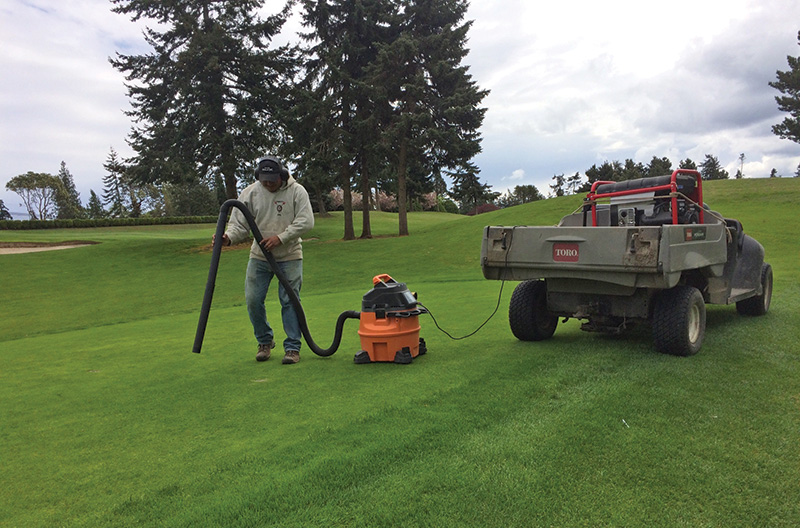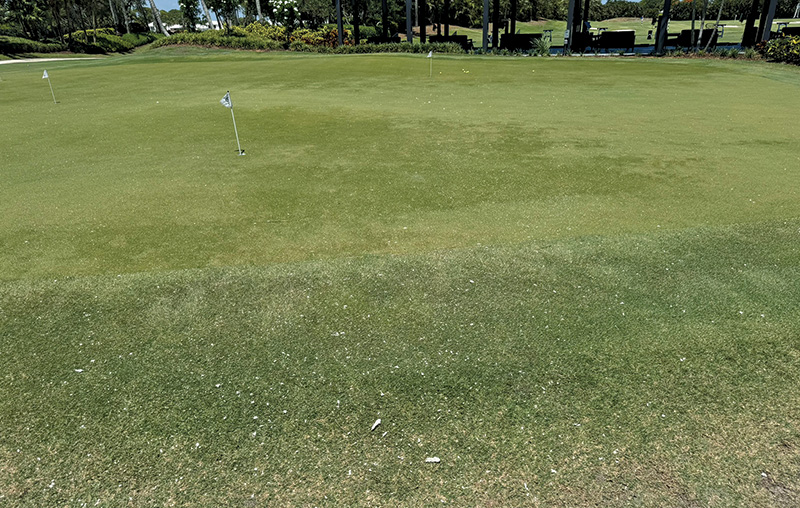Problem A: Shop vacuum on turf

Location: Bainbridge Island, Wash.
Turfgrass area: Tee
Turfgrass variety: Poa annua/bentgrass/fescue
Problem B: Snow-like material on turf in June

Location: Boca Raton, Fla.
Turfgrass area: Practice putting green
Turfgrass variety: TifEagle bermudagrass
Scroll down for answers.

Problem A: Shop vacuum on turf
This photo dates to 2017, and I find it quite a good example of how to be creative and fix problems as they arise. One of the employees on this course used the wrong grass seed in the divot mix on all of the tees. The turf on the tees and fairways are roughly 95% Poa Annua and 5% bentgrass/fescue, and the divot mix the crew uses is Chewings fescue. The superintendent had used a herbicide in the few years prior to this incident to eradicate the ryegrass and bentgrass. Because the areas were 95% Poa annua, he felt those other species looked out of place. Chewings fescue was identified as a nice fill-in grass to Poa annua, in terms of color and growth rate, and the Poa annua chokes it out more easily over time as compared to rye or bentgrass. Unfortunately, the employee used ryegrass in the divot mix by mistake, even though it was kept in a separate area under lock and key. The superintendent didn’t know how to prevent growing the undesired grass on all of the tees. He glanced out of his office and saw the shop vac in the corner and got a great idea. He went home and got his personal generator from his garage, and, voilà, he had the solution. He had the employee shop vac all the sand and seed from the divots he had just filled hours earlier, and it worked perfectly — and it turned out to be a good lesson for the employee.
Photograph submitted by Michael Goldsberry, GCSAA Class A superintendent at Wing Point Golf & Country Club in Bainbridge Island, Wash., and a 23-year association member.

Problem B: Snow-like material on turf in June
The snow-like material on this putting green thankfully was not South Florida snow in June. This practice putting green has several royal palm trees that are positioned nearby. Throughout the year but mostly in summer, the trees produce palm flower stalks, known as inflorescences. They can be quite large and produce hundreds of tiny, cream-colored flowers in showy, hanging sprays that can get up to 3 feet long. These fragrant flowers can release so much pollen that it looks like falling snow. After blooming, the flowers give way to seeds. Due to the continual falling of the debris throughout the day in this area, the crew simply mows the material up the next day or uses electric blowers to clean it off if they are just rolling greens. The golf course crew usually prunes them before the inflorescences break out of the sheath, but they are currently awaiting a new tree boom to be delivered. Luckily, no kids have brought their sleds to the course — yet.
Photograph submitted by Todd Lowe, owner of Todd Lowe Consulting. Jake Tenopir, CGCS, is director of golf course maintenance at the Polo Club of Boca Raton, Boca Raton, Fla., and a 14-year GCSAA member.
Editor’s note: Have a photo of an on-course anomaly? GCM would love to have a look! Email it to Photo Quiz author John Mascaro.
John Mascaro is the president of Turf-Tec International.